Business Law Assignment: Business Forms and Legal Responsibilities
VerifiedAdded on 2022/08/01
|8
|1371
|31
Homework Assignment
AI Summary
This business law assignment analyzes various business forms including sole proprietorships, partnerships (general, limited, and limited liability), and corporations, considering their advantages and disadvantages in the context of a restaurant startup. The assignment addresses the legal responsibilities of business owners, specifically focusing on issues of bailment and compensatory damages in scenarios involving property damage. It also explores methods for securing loans, including the use of security agreements and collateral, and discusses risk mitigation strategies employed by banks, such as credit policies and agreements. The document provides a detailed examination of the legal and financial considerations relevant to establishing and operating a restaurant, offering insights into business structure, liability, and financial security.
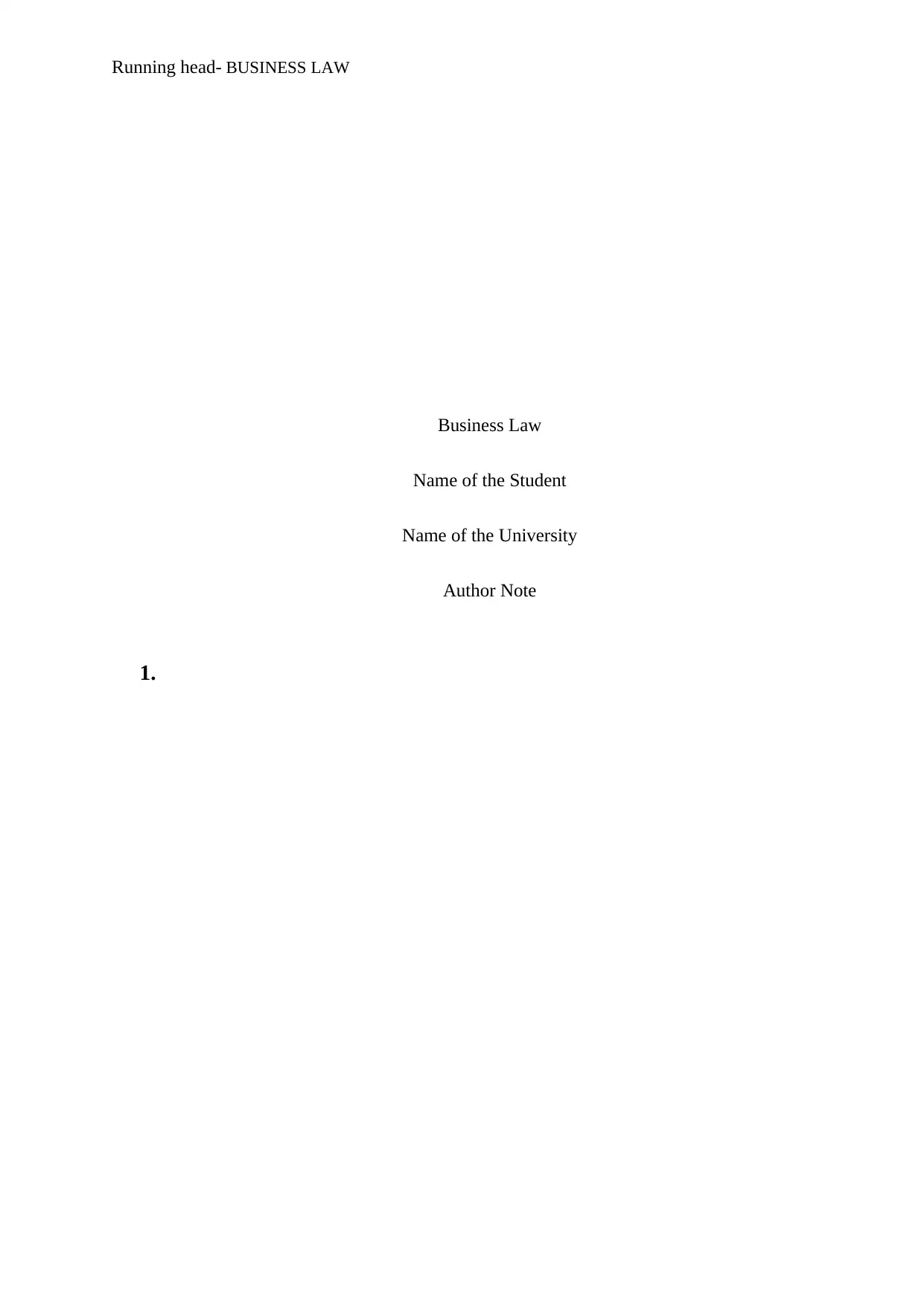
Running head- BUSINESS LAW
Business Law
Name of the Student
Name of the University
Author Note
1.
Business Law
Name of the Student
Name of the University
Author Note
1.
Paraphrase This Document
Need a fresh take? Get an instant paraphrase of this document with our AI Paraphraser
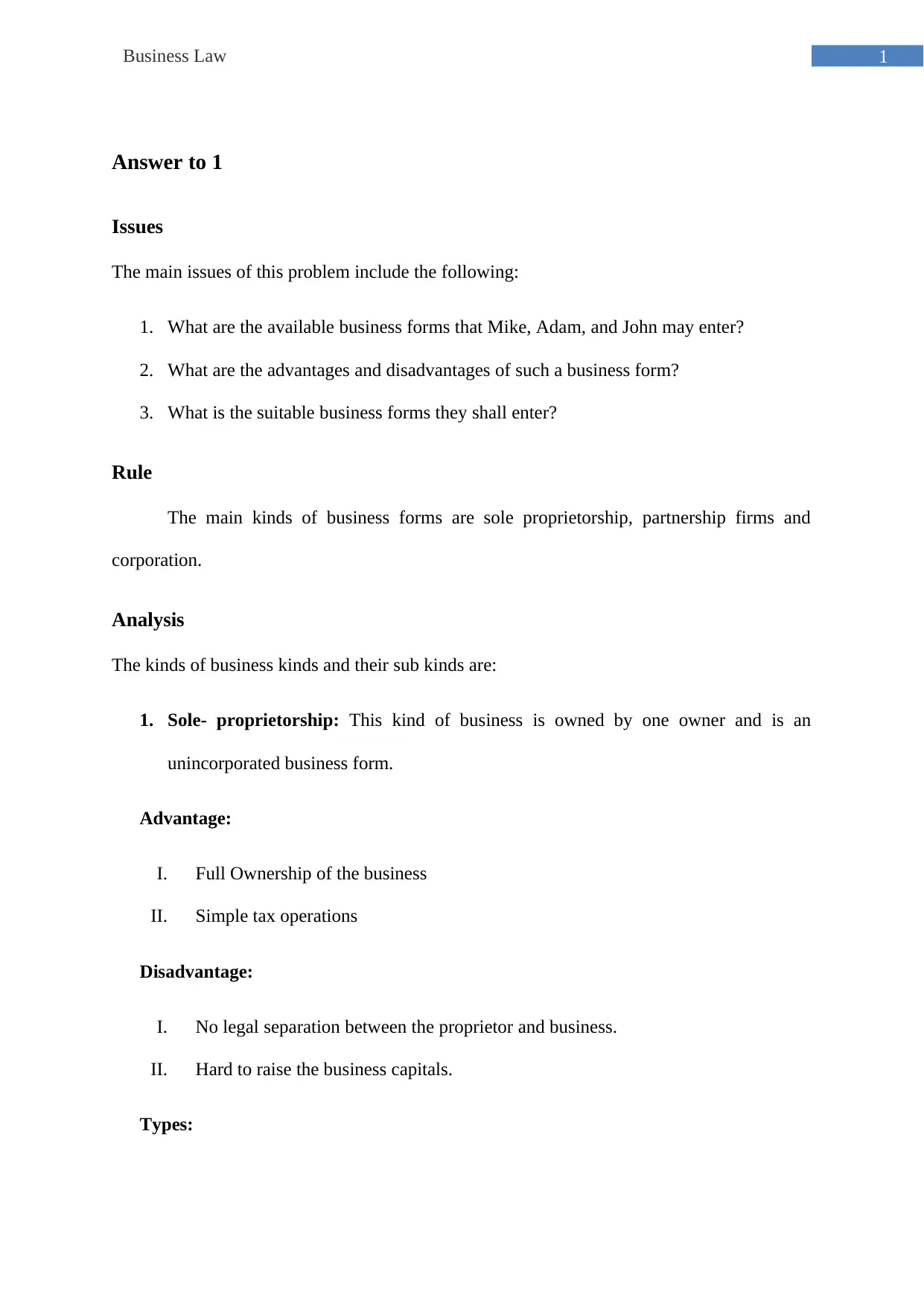
1Business Law
Answer to 1
Issues
The main issues of this problem include the following:
1. What are the available business forms that Mike, Adam, and John may enter?
2. What are the advantages and disadvantages of such a business form?
3. What is the suitable business forms they shall enter?
Rule
The main kinds of business forms are sole proprietorship, partnership firms and
corporation.
Analysis
The kinds of business kinds and their sub kinds are:
1. Sole- proprietorship: This kind of business is owned by one owner and is an
unincorporated business form.
Advantage:
I. Full Ownership of the business
II. Simple tax operations
Disadvantage:
I. No legal separation between the proprietor and business.
II. Hard to raise the business capitals.
Types:
Answer to 1
Issues
The main issues of this problem include the following:
1. What are the available business forms that Mike, Adam, and John may enter?
2. What are the advantages and disadvantages of such a business form?
3. What is the suitable business forms they shall enter?
Rule
The main kinds of business forms are sole proprietorship, partnership firms and
corporation.
Analysis
The kinds of business kinds and their sub kinds are:
1. Sole- proprietorship: This kind of business is owned by one owner and is an
unincorporated business form.
Advantage:
I. Full Ownership of the business
II. Simple tax operations
Disadvantage:
I. No legal separation between the proprietor and business.
II. Hard to raise the business capitals.
Types:
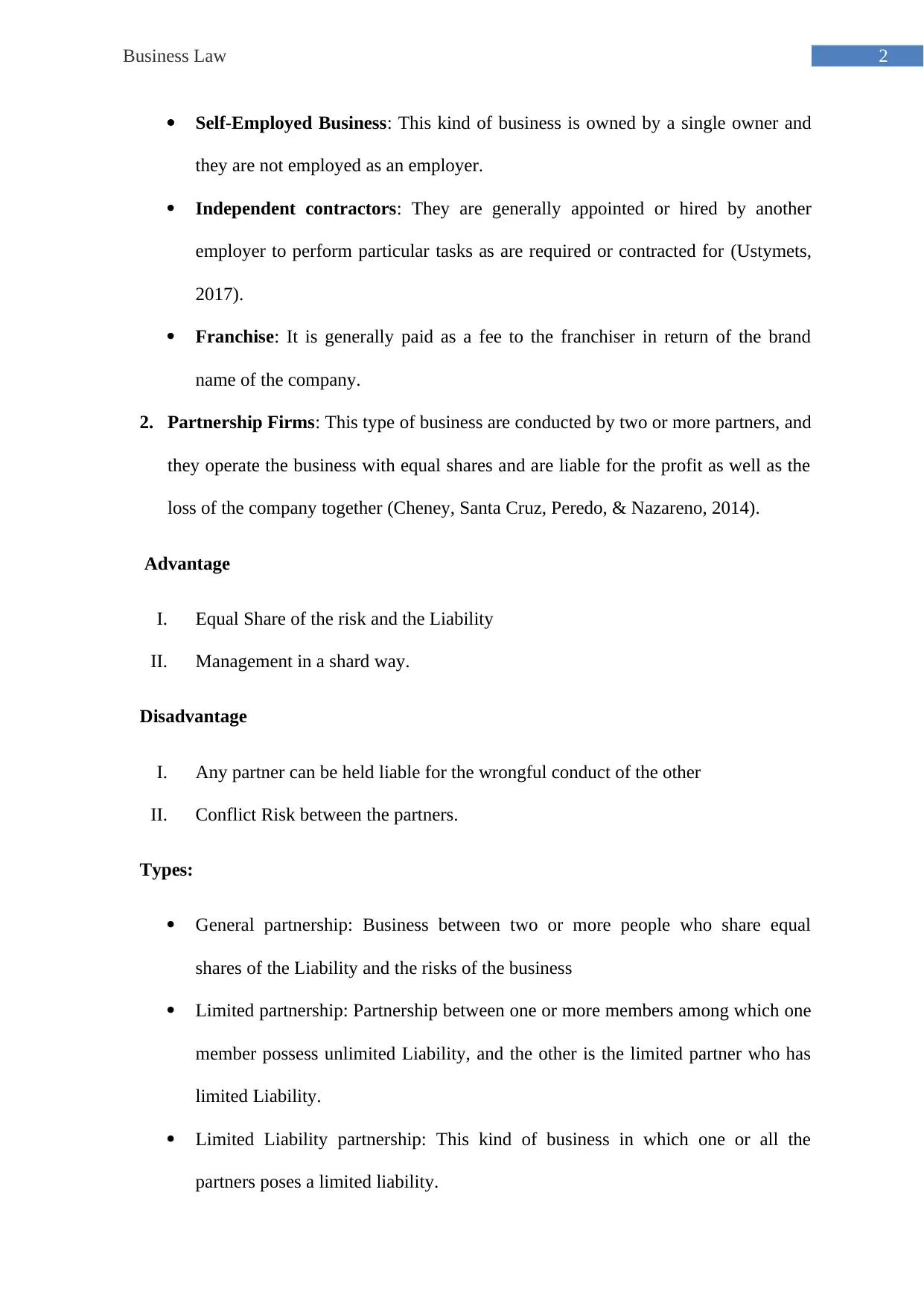
2Business Law
Self-Employed Business: This kind of business is owned by a single owner and
they are not employed as an employer.
Independent contractors: They are generally appointed or hired by another
employer to perform particular tasks as are required or contracted for (Ustymets,
2017).
Franchise: It is generally paid as a fee to the franchiser in return of the brand
name of the company.
2. Partnership Firms: This type of business are conducted by two or more partners, and
they operate the business with equal shares and are liable for the profit as well as the
loss of the company together (Cheney, Santa Cruz, Peredo, & Nazareno, 2014).
Advantage
I. Equal Share of the risk and the Liability
II. Management in a shard way.
Disadvantage
I. Any partner can be held liable for the wrongful conduct of the other
II. Conflict Risk between the partners.
Types:
General partnership: Business between two or more people who share equal
shares of the Liability and the risks of the business
Limited partnership: Partnership between one or more members among which one
member possess unlimited Liability, and the other is the limited partner who has
limited Liability.
Limited Liability partnership: This kind of business in which one or all the
partners poses a limited liability.
Self-Employed Business: This kind of business is owned by a single owner and
they are not employed as an employer.
Independent contractors: They are generally appointed or hired by another
employer to perform particular tasks as are required or contracted for (Ustymets,
2017).
Franchise: It is generally paid as a fee to the franchiser in return of the brand
name of the company.
2. Partnership Firms: This type of business are conducted by two or more partners, and
they operate the business with equal shares and are liable for the profit as well as the
loss of the company together (Cheney, Santa Cruz, Peredo, & Nazareno, 2014).
Advantage
I. Equal Share of the risk and the Liability
II. Management in a shard way.
Disadvantage
I. Any partner can be held liable for the wrongful conduct of the other
II. Conflict Risk between the partners.
Types:
General partnership: Business between two or more people who share equal
shares of the Liability and the risks of the business
Limited partnership: Partnership between one or more members among which one
member possess unlimited Liability, and the other is the limited partner who has
limited Liability.
Limited Liability partnership: This kind of business in which one or all the
partners poses a limited liability.
⊘ This is a preview!⊘
Do you want full access?
Subscribe today to unlock all pages.

Trusted by 1+ million students worldwide
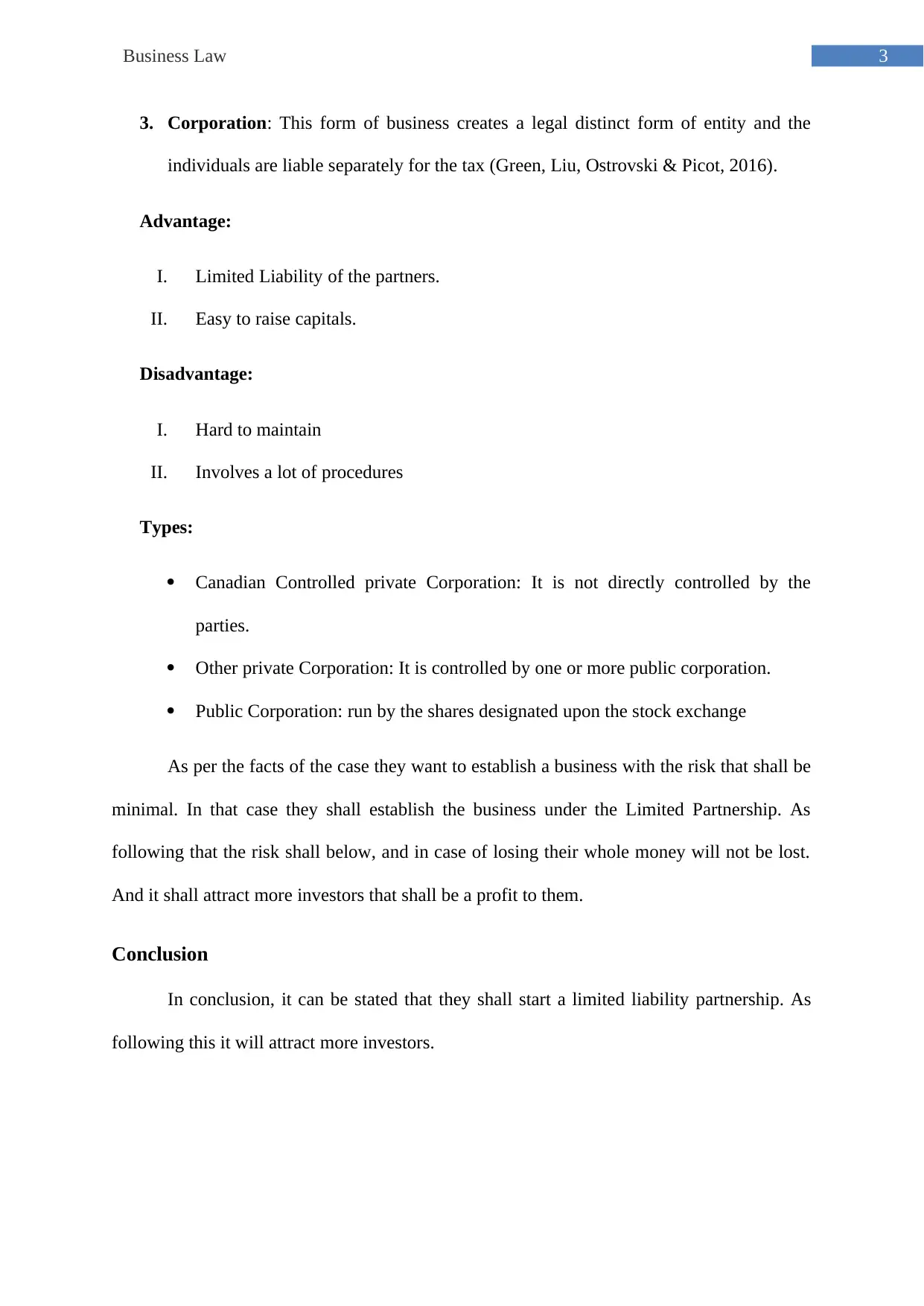
3Business Law
3. Corporation: This form of business creates a legal distinct form of entity and the
individuals are liable separately for the tax (Green, Liu, Ostrovski & Picot, 2016).
Advantage:
I. Limited Liability of the partners.
II. Easy to raise capitals.
Disadvantage:
I. Hard to maintain
II. Involves a lot of procedures
Types:
Canadian Controlled private Corporation: It is not directly controlled by the
parties.
Other private Corporation: It is controlled by one or more public corporation.
Public Corporation: run by the shares designated upon the stock exchange
As per the facts of the case they want to establish a business with the risk that shall be
minimal. In that case they shall establish the business under the Limited Partnership. As
following that the risk shall below, and in case of losing their whole money will not be lost.
And it shall attract more investors that shall be a profit to them.
Conclusion
In conclusion, it can be stated that they shall start a limited liability partnership. As
following this it will attract more investors.
3. Corporation: This form of business creates a legal distinct form of entity and the
individuals are liable separately for the tax (Green, Liu, Ostrovski & Picot, 2016).
Advantage:
I. Limited Liability of the partners.
II. Easy to raise capitals.
Disadvantage:
I. Hard to maintain
II. Involves a lot of procedures
Types:
Canadian Controlled private Corporation: It is not directly controlled by the
parties.
Other private Corporation: It is controlled by one or more public corporation.
Public Corporation: run by the shares designated upon the stock exchange
As per the facts of the case they want to establish a business with the risk that shall be
minimal. In that case they shall establish the business under the Limited Partnership. As
following that the risk shall below, and in case of losing their whole money will not be lost.
And it shall attract more investors that shall be a profit to them.
Conclusion
In conclusion, it can be stated that they shall start a limited liability partnership. As
following this it will attract more investors.
Paraphrase This Document
Need a fresh take? Get an instant paraphrase of this document with our AI Paraphraser

4Business Law
Answer to 2
Issue
1. What is the legal responsibility John own?
2. Will the responsibility change in case the truck was rented?
Rule
The rule that shall be followed for the damages is compensatory damages that has been
occurred due to the miscalculations and under the bailment for the value.
Analysis
The legal responsibility that is owned by John is of a bailor. A bailor is generally
defined as a the owners of a property that he transfers to someone else who is a bailee who
received the possession of the property for the particular time. Following the bailment the
property is transferred for a limited time where the other person gets the possession of it
(Sheehan, 2017). In a case where he had rented it, John shall possess the general Liability as a
bailee. It includes to care of the goods in the absence of the actual owner. In case where
money is involved the bailor shall be eligible to get the compensatory damages for the
vehicle. In this case due to John’s miscalculation the vehicle suffered serious damage. So his
Liability is limited to the payment for the damages as compensation.
Conclusion
In conclusion, it is stated that John owns the duty as a bailee for the bailment of value
and shall pay compensatory damages for the damage caused to the vehicle.
Answer to 2
Issue
1. What is the legal responsibility John own?
2. Will the responsibility change in case the truck was rented?
Rule
The rule that shall be followed for the damages is compensatory damages that has been
occurred due to the miscalculations and under the bailment for the value.
Analysis
The legal responsibility that is owned by John is of a bailor. A bailor is generally
defined as a the owners of a property that he transfers to someone else who is a bailee who
received the possession of the property for the particular time. Following the bailment the
property is transferred for a limited time where the other person gets the possession of it
(Sheehan, 2017). In a case where he had rented it, John shall possess the general Liability as a
bailee. It includes to care of the goods in the absence of the actual owner. In case where
money is involved the bailor shall be eligible to get the compensatory damages for the
vehicle. In this case due to John’s miscalculation the vehicle suffered serious damage. So his
Liability is limited to the payment for the damages as compensation.
Conclusion
In conclusion, it is stated that John owns the duty as a bailee for the bailment of value
and shall pay compensatory damages for the damage caused to the vehicle.
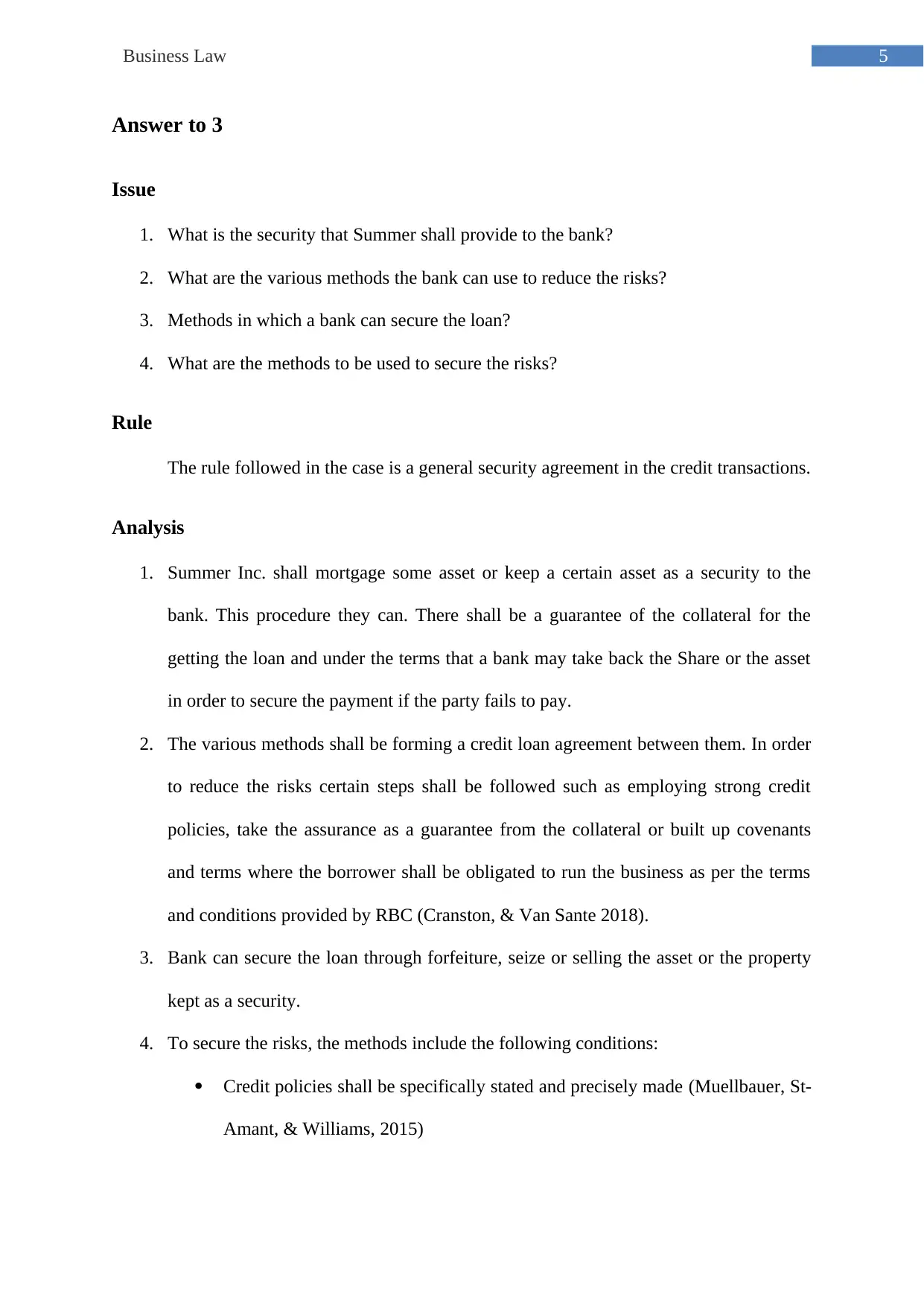
5Business Law
Answer to 3
Issue
1. What is the security that Summer shall provide to the bank?
2. What are the various methods the bank can use to reduce the risks?
3. Methods in which a bank can secure the loan?
4. What are the methods to be used to secure the risks?
Rule
The rule followed in the case is a general security agreement in the credit transactions.
Analysis
1. Summer Inc. shall mortgage some asset or keep a certain asset as a security to the
bank. This procedure they can. There shall be a guarantee of the collateral for the
getting the loan and under the terms that a bank may take back the Share or the asset
in order to secure the payment if the party fails to pay.
2. The various methods shall be forming a credit loan agreement between them. In order
to reduce the risks certain steps shall be followed such as employing strong credit
policies, take the assurance as a guarantee from the collateral or built up covenants
and terms where the borrower shall be obligated to run the business as per the terms
and conditions provided by RBC (Cranston, & Van Sante 2018).
3. Bank can secure the loan through forfeiture, seize or selling the asset or the property
kept as a security.
4. To secure the risks, the methods include the following conditions:
Credit policies shall be specifically stated and precisely made (Muellbauer, St-
Amant, & Williams, 2015)
Answer to 3
Issue
1. What is the security that Summer shall provide to the bank?
2. What are the various methods the bank can use to reduce the risks?
3. Methods in which a bank can secure the loan?
4. What are the methods to be used to secure the risks?
Rule
The rule followed in the case is a general security agreement in the credit transactions.
Analysis
1. Summer Inc. shall mortgage some asset or keep a certain asset as a security to the
bank. This procedure they can. There shall be a guarantee of the collateral for the
getting the loan and under the terms that a bank may take back the Share or the asset
in order to secure the payment if the party fails to pay.
2. The various methods shall be forming a credit loan agreement between them. In order
to reduce the risks certain steps shall be followed such as employing strong credit
policies, take the assurance as a guarantee from the collateral or built up covenants
and terms where the borrower shall be obligated to run the business as per the terms
and conditions provided by RBC (Cranston, & Van Sante 2018).
3. Bank can secure the loan through forfeiture, seize or selling the asset or the property
kept as a security.
4. To secure the risks, the methods include the following conditions:
Credit policies shall be specifically stated and precisely made (Muellbauer, St-
Amant, & Williams, 2015)
⊘ This is a preview!⊘
Do you want full access?
Subscribe today to unlock all pages.

Trusted by 1+ million students worldwide
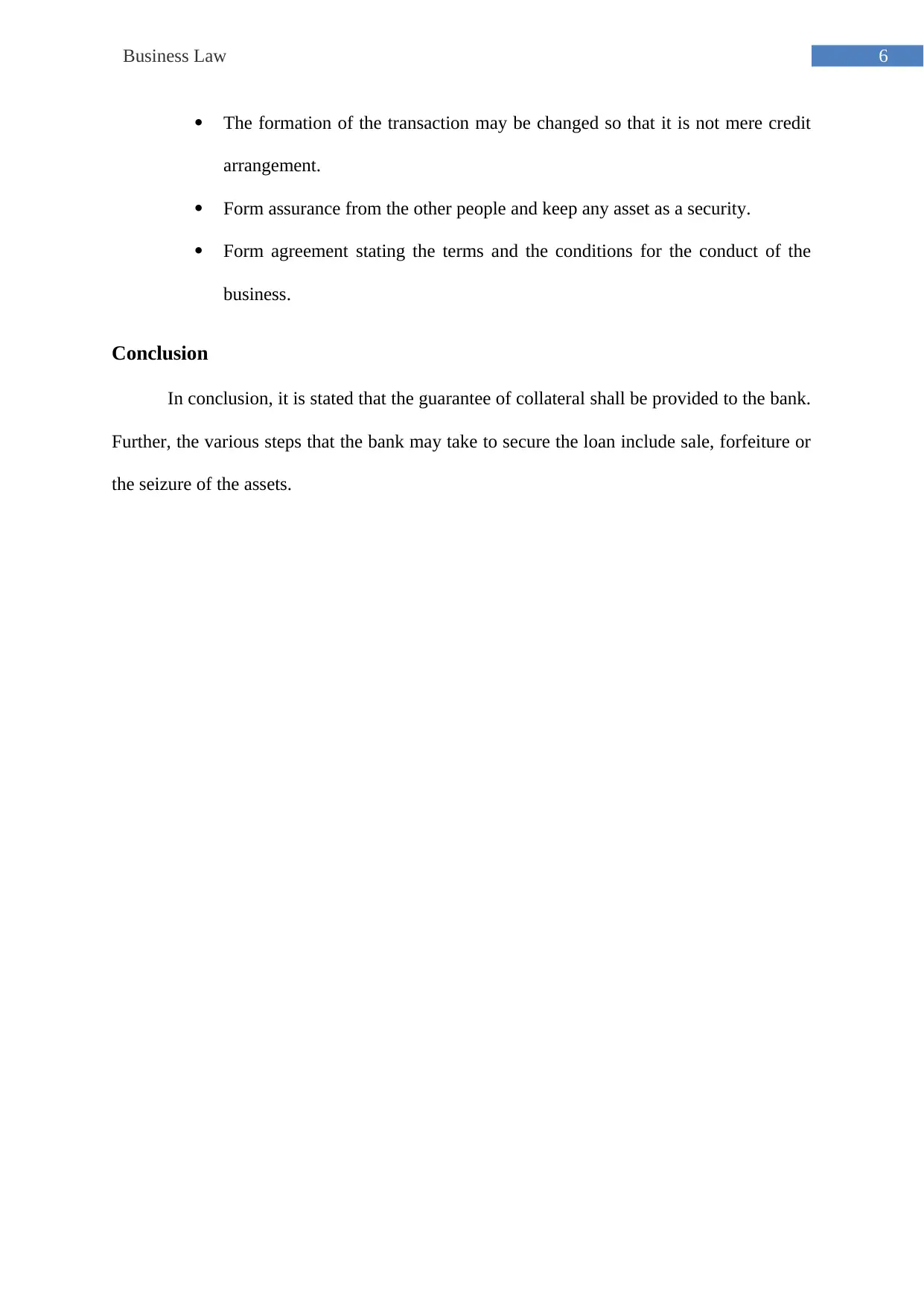
6Business Law
The formation of the transaction may be changed so that it is not mere credit
arrangement.
Form assurance from the other people and keep any asset as a security.
Form agreement stating the terms and the conditions for the conduct of the
business.
Conclusion
In conclusion, it is stated that the guarantee of collateral shall be provided to the bank.
Further, the various steps that the bank may take to secure the loan include sale, forfeiture or
the seizure of the assets.
The formation of the transaction may be changed so that it is not mere credit
arrangement.
Form assurance from the other people and keep any asset as a security.
Form agreement stating the terms and the conditions for the conduct of the
business.
Conclusion
In conclusion, it is stated that the guarantee of collateral shall be provided to the bank.
Further, the various steps that the bank may take to secure the loan include sale, forfeiture or
the seizure of the assets.
Paraphrase This Document
Need a fresh take? Get an instant paraphrase of this document with our AI Paraphraser
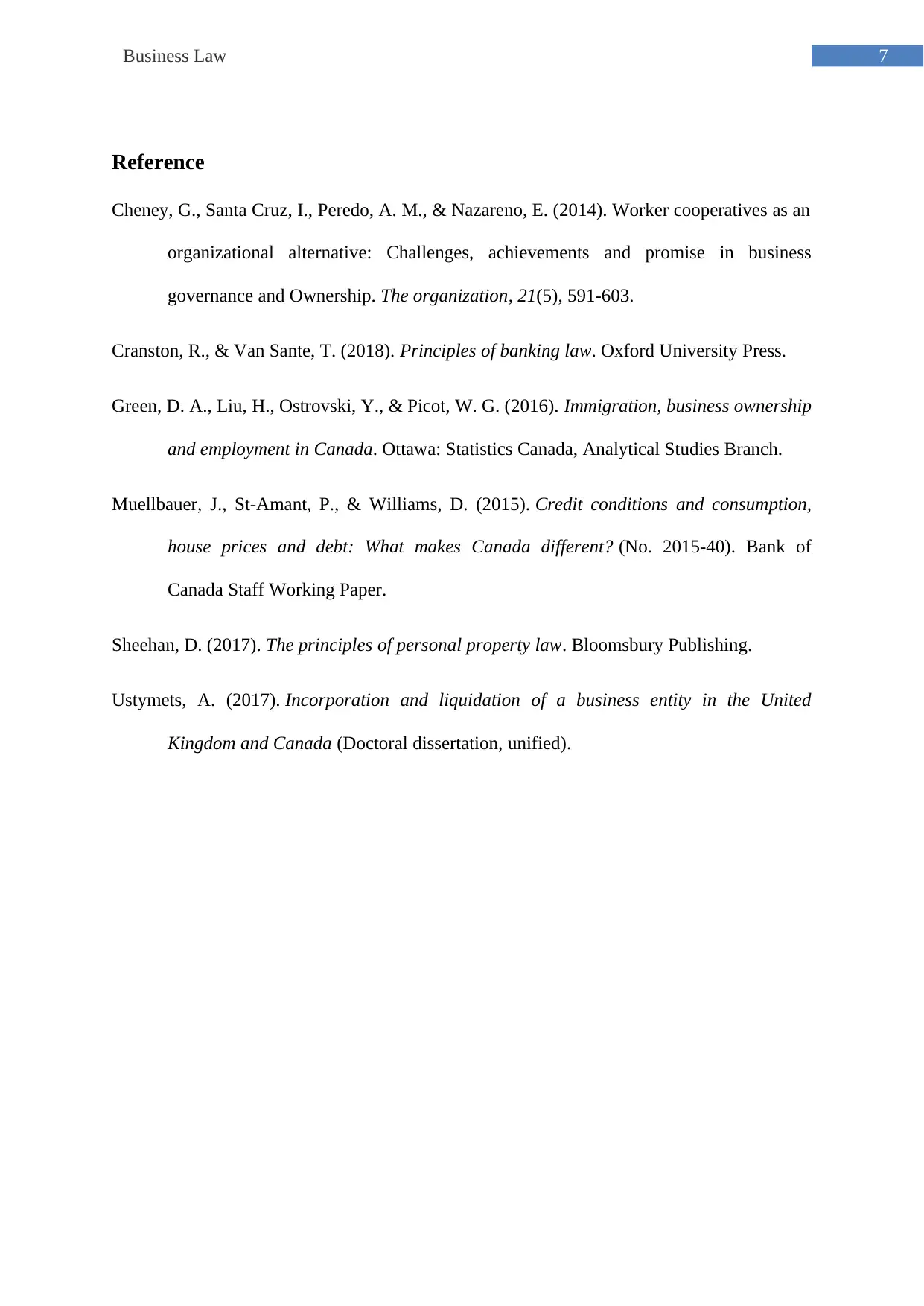
7Business Law
Reference
Cheney, G., Santa Cruz, I., Peredo, A. M., & Nazareno, E. (2014). Worker cooperatives as an
organizational alternative: Challenges, achievements and promise in business
governance and Ownership. The organization, 21(5), 591-603.
Cranston, R., & Van Sante, T. (2018). Principles of banking law. Oxford University Press.
Green, D. A., Liu, H., Ostrovski, Y., & Picot, W. G. (2016). Immigration, business ownership
and employment in Canada. Ottawa: Statistics Canada, Analytical Studies Branch.
Muellbauer, J., St-Amant, P., & Williams, D. (2015). Credit conditions and consumption,
house prices and debt: What makes Canada different? (No. 2015-40). Bank of
Canada Staff Working Paper.
Sheehan, D. (2017). The principles of personal property law. Bloomsbury Publishing.
Ustymets, A. (2017). Incorporation and liquidation of a business entity in the United
Kingdom and Canada (Doctoral dissertation, unified).
Reference
Cheney, G., Santa Cruz, I., Peredo, A. M., & Nazareno, E. (2014). Worker cooperatives as an
organizational alternative: Challenges, achievements and promise in business
governance and Ownership. The organization, 21(5), 591-603.
Cranston, R., & Van Sante, T. (2018). Principles of banking law. Oxford University Press.
Green, D. A., Liu, H., Ostrovski, Y., & Picot, W. G. (2016). Immigration, business ownership
and employment in Canada. Ottawa: Statistics Canada, Analytical Studies Branch.
Muellbauer, J., St-Amant, P., & Williams, D. (2015). Credit conditions and consumption,
house prices and debt: What makes Canada different? (No. 2015-40). Bank of
Canada Staff Working Paper.
Sheehan, D. (2017). The principles of personal property law. Bloomsbury Publishing.
Ustymets, A. (2017). Incorporation and liquidation of a business entity in the United
Kingdom and Canada (Doctoral dissertation, unified).
1 out of 8
Related Documents
Your All-in-One AI-Powered Toolkit for Academic Success.
+13062052269
info@desklib.com
Available 24*7 on WhatsApp / Email
![[object Object]](/_next/static/media/star-bottom.7253800d.svg)
Unlock your academic potential
Copyright © 2020–2025 A2Z Services. All Rights Reserved. Developed and managed by ZUCOL.




